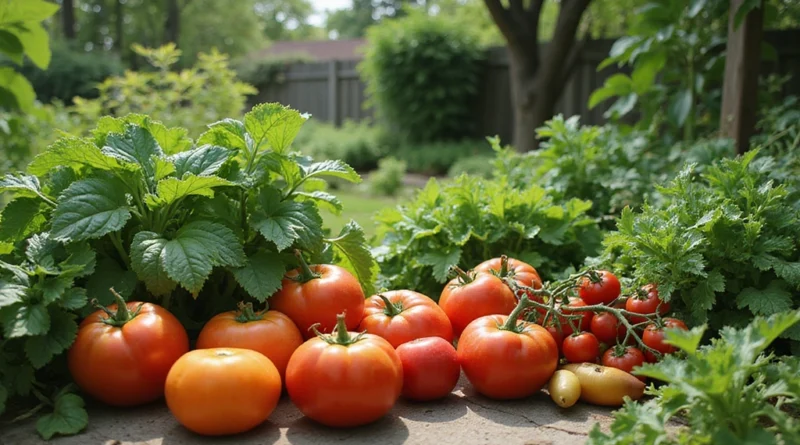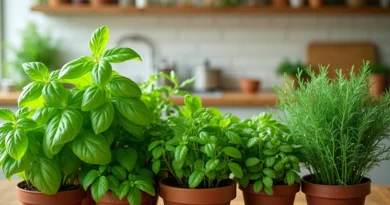Step By Step: How to Grow Vegetables in Your Backyard Like a Pro
Growing your own vegetables can be one of the most rewarding experiences, transforming your backyard into a vibrant home garden. With the right techniques and a sprinkle of patience, you can cultivate a bounty of fresh produce right outside your door. Imagine the satisfaction of harvesting your tomatoes, peppers, and greens, knowing you’ve nurtured their growth from seed to table. By following these straightforward steps, you’ll be well on your way to becoming a vegetable gardening pro.
Start with a little planning and soon enough, your garden will be bursting with life and flavor. Let’s dig in and start this green journey together!
1. Choose the Right Location

The secret to a flourishing vegetable garden starts with the right location. Ideally, you want a spot that gets at least 6-8 hours of sunlight a day, as most vegetables thrive in bright light. Look for a flat area to avoid water pooling, and consider proximity to your home for easy access. A well-drained site is also essential, as soggy roots can lead to disease. Before you plant, observe how the sun moves across your yard to pinpoint the sunniest spots.
– Check soil drainage by digging a small hole and filling it with water. If it takes more than a few hours to drain, consider raised beds.
– Keep an eye out for large trees that might cast shade or compete for nutrients.
– Think about convenience for watering and harvesting. A nearby hose can make all the difference!
Choosing the right location sets the tone for a successful garden.
2. Test Your Soil

Healthy soil is the backbone of any great garden. Before diving into planting, take a soil test to check its pH and nutrient levels. You can buy a soil test kit or send a sample to a local extension office. Most vegetables prefer a pH between 6.0 and 7.0, slightly acidic to neutral. Based on the test results, you might need to amend your soil with organic matter, compost, or fertilizers to boost nutrients.
– Add compost to improve soil structure and provide nutrients.
– If your soil is too acidic, adding lime can help raise the pH.
– For alkaline soils, sulfur is an effective way to bring pH down.
By nurturing your soil, you’re setting the stage for robust vegetable growth.
3. Plan Your Vegetable Layout

Designing your garden layout is like creating a masterpiece. Think about how much space each vegetable needs to grow and plan accordingly. Taller plants like tomatoes should be at the back, while shorter ones like radishes can go up front. Consider companion planting—some plants work better together and can even deter pests!
– Create rows or raised beds to maximize space and make maintenance easier.
– Use vertical gardening techniques such as trellises for climbing plants.
– Allow room for pathways so you can tend to your plants without trampling them.
With a well-thought-out layout, your garden will not only be functional but also beautifully organized.
4. Select the Right Seeds or Seedlings

Now comes the fun part—choosing what to grow! Whether you opt for seeds or seedlings, make sure to select varieties suitable for your climate and soil type. Local garden centers often have regionally adapted plants, and heirloom varieties can offer unique flavors. If you’re new to gardening, starting with seedlings can give you a head start.
– Look for disease-resistant varieties to ensure a healthier garden.
– Consider growing a mix of fast-growing vegetables like radishes and slower ones like carrots to extend your harvest.
– Keep an eye on your growing zone; it helps in selecting the best crops for your area.
The right choices here can lead to a productive and satisfying garden experience.
5. Master the Art of Planting

Planting your seeds or seedlings requires a little care. Follow the instructions on the seed packet for depth and spacing. Generally, seeds should be sown at a depth of about two to three times their size. If you’re transplanting seedlings, make sure to handle them gently, keeping the root ball intact. Water them immediately after planting to settle the soil around the roots.
– Mulch around your plants to retain moisture and suppress weeds.
– If you’re planting seeds, mark rows with simple stakes, so you remember where everything is planted.
– Be mindful of frost dates; check local guides to avoid planting too early.
By mastering planting techniques, you’re setting your garden up for success right from the start.
6. Watering Wisely

Watering is an essential part of garden care, but knowing how much to water can be tricky. Generally, vegetables need about an inch of water per week. Water deeply but less frequently to encourage deep root growth. Consider using a drip irrigation system or soaker hoses to provide consistent moisture without over-saturating.
– Water in the morning to minimize evaporation and fungal diseases.
– Mulching can help retain moisture and reduce the frequency of watering.
– Monitor your plants; droopy leaves can indicate thirst, while yellowing can suggest overwatering.
With a good watering routine, your veggies will thrive and grow strong.
7. Fertilize for Success

Fertilizing your garden is key to growing lush vegetables. Depending on your soil test results, you may need to add fertilizers at different stages of growth. Choose organic options like compost or well-rotted manure for a natural boost. Be cautious not to over-fertilize, as this can lead to leafy plants with little fruit or root.
– A balanced fertilizer with nitrogen, phosphorus, and potassium is often best.
– Side-dress plants with compost during the growing season for extra nutrients.
– Consider using organic liquid fertilizers for quick absorption.
Good fertilization practices can lead to a bountiful harvest that will make you proud.
8. Pest and Disease Management

Keeping your garden free from pests is crucial for a healthy harvest. Regularly inspect plants for signs of pests like aphids or caterpillars. Encourage beneficial insects such as ladybugs and lacewings by planting a variety of flowers. If you identify a pest problem, try organic solutions like neem oil or insecticidal soap before resorting to harsher chemicals.
– Create physical barriers like row covers to protect young plants.
– Rotate crops yearly to help prevent soil-borne diseases.
– Practice good garden hygiene by cleaning up debris where pests can hide.
With vigilant monitoring and proactive measures, your vegetables can thrive without unwanted guests.
9. Harvest at the Right Time

The moment you’ve been waiting for—harvesting! Picking your vegetables at the right time ensures maximum flavor and nutrition. Generally, vegetables are best harvested in the morning when temperatures are cooler. Check for signs of ripeness; for instance, tomatoes should be fully colored and slightly soft, while greens should be vibrant and crisp.
– Use sharp scissors or garden shears to avoid damaging plants.
– Harvest regularly to encourage more growth.
– Store your harvest properly to maintain freshness.
Timing your harvest can make all the difference in enjoying the fruits of your labor.
10. Enjoy Your Home Garden

Congratulations on nurturing your garden! The final step is to enjoy the fruits of your labor, literally. Incorporate your fresh vegetables into meals, share with friends, or preserve them for later. Consider starting a garden journal to document your experiences, noting what worked and what didn’t. This way, each season can be even better than the last!
– Experiment with recipes that highlight your harvest. Fresh salads, homemade salsas, or simple roasted veggies can be delightful.
– Invite friends over for a garden party to showcase your hard work.
– Share seeds or cuttings with fellow gardening enthusiasts to keep the cycle going.
Finding joy in your home garden is the ultimate reward of vegetable gardening.
Conclusion

Growing your own vegetables isn’t just about the food; it’s about embracing a lifestyle. Each step you take in your gardening journey brings you closer to understanding nature and where your food comes from. Celebrate your successes and learn from your challenges, and don’t hesitate to share your gardening tales with fellow enthusiasts. Happy gardening!
With the right techniques and a little love, your backyard can transform into a paradise of fresh produce.



